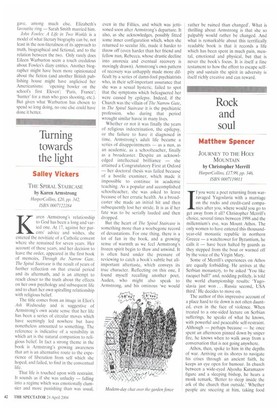Turning towards the light
Salley Vickers
THE SPIRAL STAIRCASE by Karen Armstrong HarperCollins, £20, pp. 342, ISBN 0007122284 Karen Armstrong's relationship to God has been a long and varied one. At 17. against her parents' advice and wishes, she entered the novitiate of a Catholic convent where she remained for seven years. Her account of these years, and her decision to leave the order, appeared in the first book of memoirs, Through the Narrow Gate. The Spiral Staircase is the result of years of further reflection on that crucial period and its aftermath, and is an attempt to reach closer to the truth about the effects on her own psychology and subsequent life and to chart her own spiralling relationship with religious belief. The title comes from an image in Eliot's Ash Wednesday and is suggestive of Armstrong's own acute sense that her life has been a series of circular moves which have seemingly led nowhere but have nonetheless amounted to something. The reference is indicative of a sensibility in which art is the natural companion to religious belief. In fact a strong theme in the book is Armstrong's growing awareness that art is an alternative route to the experience of liberation from self which she hoped, and failed, to find in the conventual life. That life is touched upon with restraint. It sounds as if she was unlucky — falling into a regime which was emotionally clumsier and more punishing than was usual, even in the Fifties, and which was jettisoned soon after Armstrong's departure. It also, as she acknowledges, possibly fitted some inner configuration which, when she returned to secular life, made it harder to throw off (even harder than her friend and fellow nun, Rebecca, whose drastic decline into anorexia and eventual recovery is movingly drawn). Armstrong's own pattern of recovery was unhappily made more difficult by a series of damn-fool psychiatrists who, in their self-important assurance that she was a sexual hysteric, failed to spot that the symptoms which beleaguered her were caused by epilepsy. Indeed, if the Church was the villain of The Narrow Gate, in The Spiral Staircase it is the psychiatric profession, who during that period wrought similar havoc in many lives. Whether or not it was finally the years of religious indoctrination, the epilepsy, or the failure to have it diagnosed in time, Armstrong's adult life became a series of disappointments — as a nun, as an academic, as a schoolteacher, finally as a broadcaster. Despite an acknowledged intellectual brilliance — she attained a Congratulatory First at Oxford — her doctoral thesis was failed because of a hostile examiner, which made it impossible to continue in academic teaching. As a popular and accomplished schoolteacher, she was asked to leave because of her erratic health. As a broadcaster she made an initial hit and then subsequently lost her stride. It is as if her fate was to be serially lauded and then dropped. But the heart of The Spiral Staircase is something more than a woebegone record of devastations. For one thing, there is a lot of fun in the book, and a growing sense of warmth as we feel Armstrong's frozen spirit begin to thaw and unwind. It is often hard under the pressure of reviewing to catch a book's subtle but allimportant aftertaste, which conveys its true character. Reflecting on this one, I found myself recalling another poet, Auden, who might also speak to Armstrong, and his ominous 'we would rather be ruined than changed'. What is thrilling about Armstrong is that she so palpably would rather be changed. And what is remarkable about this terrifically readable book is that it records a life which has been spent in much pain, mental, emotional and physical, but that is never the book's focus. It is itself a fine testament to how the effort to escape selfpity and sustain the spirit in adversity is itself richly creative and can reward.


















































































 Previous page
Previous page